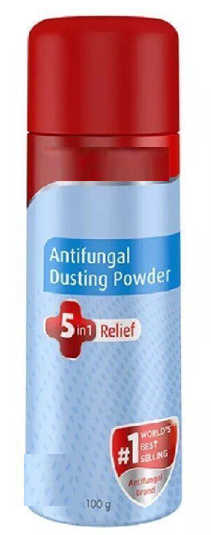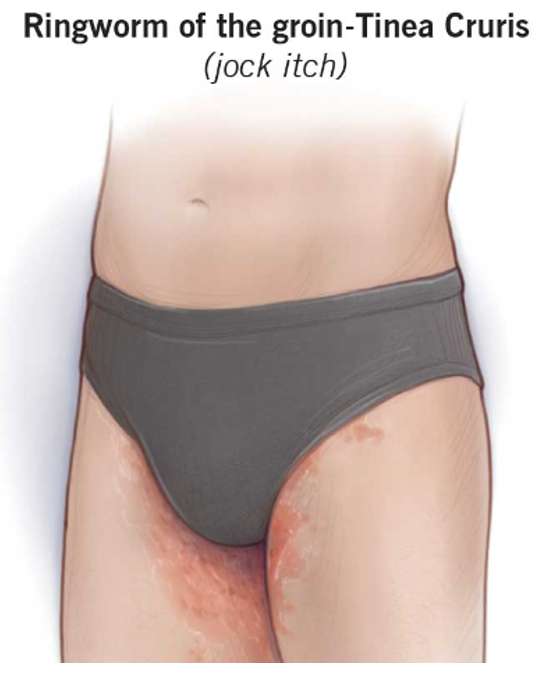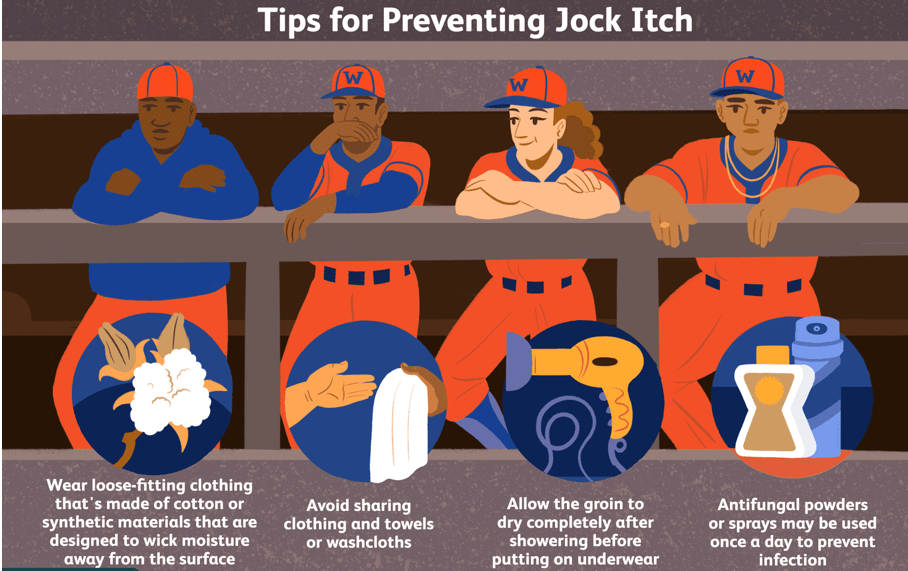Ringworm
According to NHS UK NHS UK Ringworm "Ringworm is a common fungal infection. It is not caused by worms. You can usually buy medicine from a pharmacy to treat it".
The main symptom of ringworm is a rash. It may look red or darker than the surrounding skin, depending on your skin tone. The rash may be scaly, dry, swollen or itchy. Ringworm can appear anywhere on the body, including the scalp (tinea capitis) and the groin (tinea cruris commonly referred to as jock itch).
Jock itch is a fungal skin infection that causes an itchy rash in warm, moist areas of the body. The rash often affects the groin and inner thighs and may be shaped like a ring. Jock itch gets its name because it's common in athletes. It's also common in people who sweat a lot. The condition can range from mild to serious. It usually clears up in 1 to 3 weeks with antifungal creams and self care.
Symptoms of jock itch are:
- A spreading rash that begins in the crease of the groin and moves down the upper thigh and buttocks.
- A rash whose center tends to clear as the rash spreads.
- A rash that may be full or partially ring shaped.
- A rash bordered with small blisters.
- Itchiness.
- Scaly skin.
- A rash that might be red, brown, purple or gray depending on your skin color.
Causes
Jock itch is caused by fungi that thrive in warm, moist areas of the body. Jock itch is often caused by the same organism that causes athlete's foot. The rash can spread from person to person with skin contact or from sharing contaminated towels or clothing. You can also spread an infection from the foot to groin by way of the hands or a towel.
You're at greater risk of jock itch if you:
- Are male.
- Are a teen or young adult.
- Wear underwear, jeans or other clothing that's tight.
- Sweat heavily in the groin area
- Have a weak immune system.
- Have athlete's foot.
- Leaving on a wet bathing suit for a long time
- Sharing damp towels or sweaty clothing
- Being in close contact with someone infected
Prevention tips for reducing the risk of jock itch include:
-
Stay dry. Keep the groin area and inner thighs dry by drying with a clean towel after showering or exercising. Dry your feet last to avoid spreading athlete's foot to the groin area.
-
Wear clean clothes. Change your underwear at least once a day or more often if you sweat a lot. It helps to wear underwear made of cotton or other fabric that breathes and keeps the skin drier. Wash workout clothes after each use.
-
Find the correct fit. Choose underwear, athletic supporters and sports uniforms that fit well. Tight-fitting clothes can chafe your skin and up the risk of jock itch. Try wearing boxer shorts rather than briefs.
-
Don't share personal items. Don't let others use your clothing, towels or other personal items. Don't borrow such items from others.
-
Treat or prevent athlete's foot. Control athlete's foot to prevent its spread to the groin. Prevent athlete's foot by wearing waterproof footwear around public pools and in showers and locker rooms.
Jock itch treatments:




